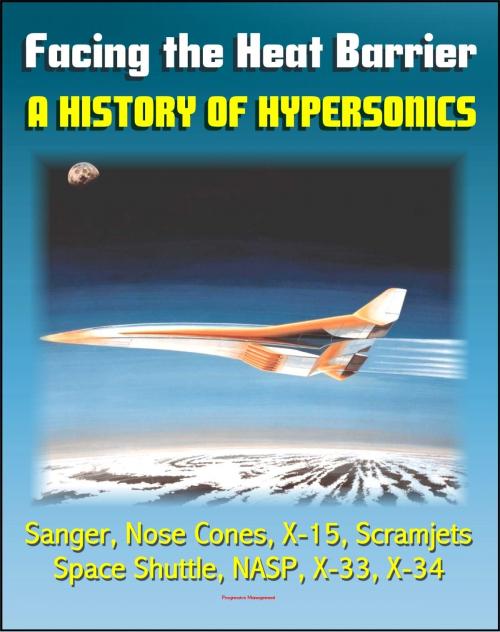Facing the Heat Barrier: A History of Hypersonics - V-2, Sanger, Missile Nose Cones, X-15, Scramjets, Space Shuttle, National Aerospace Plane (NASP), X-33, X-34 (NASA SP-2007-4232)
Nonfiction, Reference & Language, Transportation, Aviation, Science & Nature, Science, Physics, Astrophysics & Space Science| Author: | Progressive Management | ISBN: | 9781465713551 |
| Publisher: | Progressive Management | Publication: | February 29, 2012 |
| Imprint: | Smashwords Edition | Language: | English |
| Author: | Progressive Management |
| ISBN: | 9781465713551 |
| Publisher: | Progressive Management |
| Publication: | February 29, 2012 |
| Imprint: | Smashwords Edition |
| Language: | English |
This official NASA history document - converted for accurate flowing-text e-book format reproduction - is a fascinating and comprehensive account of the history of hypersonics, the study of flight where aerodynamic heating dominates the physics of the problem, normally at Mach 5 and higher. The text covers many famous programs and vehicles, including the V-2, missile nose cones, the X-15, scramjet technology, the Space Shuttle, the National Aerospace Plane (NASP), the X-33, and X-34.
Chapter 1 covers the immediate postwar years, when America still had much to learn from the Europeans. It focuses on two individuals: Eugen Sanger, who gave the first proposal for a hypersonic bomber, and John Becker, who built America's first hypersonic wind tunnel. Chapter 2 covers the first important area of hypersonic research and development, which supported the advent of strategic missiles during the 1950s. The focus was on solving the re-entry problem, and this chapter follows the story through flight tests of complete nose cones. Chapter 3 deals with the X-15, which took shape at a time when virtually the whole of America's capability in hypersonics research was contained within Becker's 11-inch instrument. Today it is hard to believe that so bold and so successful a step in aviation research could stand on so slender a foundation. Chapter 4 introduces hypersonic propulsion and emphasizes the work of Antonio Ferri, an Italian aerodynamicist who was the first to give a credible concept for a scramjet engine. This chapter also surveys Aerospaceplane, a little-known program of paper studies that investigated the feasibility of flight to orbit using such engines. The next two chapters cover important developments in re-entry that followed the ICBM. Chapter 5, "Widening Prospects for Re-Entry," shows how work in this area supported the manned space program while failing to offer a rationale for a winged spacecraft, Dyna-Soar. Chapter 6, "Hypersonics and the Shuttle," begins by outlining developments during the mid-1960s that made it plausible that NASA's reusable space transporter would be designed as a lifting body and built using hot structures. Chapter 7, "The Fading, the Comeback," shows how work with scramjets did not share the priority afforded to the topic of re-entry. Instead it faded, and by the late 1960s only NASA-Langley was still pursuing studies in this area. This ongoing effort nevertheless gave important background to the National Aerospace Plane— but it was not technical success that won approval for NASP. As noted, it was the Strategic Defense Initiative. NASP was not well-founded at the outset; it was more of a leap of faith. Chapter 8, "Why NASP Fell Short," explains what happened. In summary, the estimated performance of its scramjet engine fell well below initial hopes, while the drag was higher than expected. Computational aerodynamics failed to give accurate estimates in critical technical areas. The ejector ramjet, a key element of the propulsion system, proved to lack the desired performance. In the area of materials, metallurgists scored an impressive success with a new type of titanium called Beta-21S. It had only half the density of the superalloys that had been slated for Dyna-Soar, but even greater weight savings would have been needed for NASP. Finally, Chapter 9 discusses "Hypersonics After NASP." Recent developments include the X-33 and X-34 launch vehicles, which represent continuing attempts to build the next launch vehicle. Scramjets have lately taken flight, not only as NASA's X-43A but also in Russia and in Australia. In addition, the new topic of Large Eddy Simulation, in computational fluid mechanics, raises the prospect that analysts indeed may learn, at least on paper, just how good a scramjet may be.
This official NASA history document - converted for accurate flowing-text e-book format reproduction - is a fascinating and comprehensive account of the history of hypersonics, the study of flight where aerodynamic heating dominates the physics of the problem, normally at Mach 5 and higher. The text covers many famous programs and vehicles, including the V-2, missile nose cones, the X-15, scramjet technology, the Space Shuttle, the National Aerospace Plane (NASP), the X-33, and X-34.
Chapter 1 covers the immediate postwar years, when America still had much to learn from the Europeans. It focuses on two individuals: Eugen Sanger, who gave the first proposal for a hypersonic bomber, and John Becker, who built America's first hypersonic wind tunnel. Chapter 2 covers the first important area of hypersonic research and development, which supported the advent of strategic missiles during the 1950s. The focus was on solving the re-entry problem, and this chapter follows the story through flight tests of complete nose cones. Chapter 3 deals with the X-15, which took shape at a time when virtually the whole of America's capability in hypersonics research was contained within Becker's 11-inch instrument. Today it is hard to believe that so bold and so successful a step in aviation research could stand on so slender a foundation. Chapter 4 introduces hypersonic propulsion and emphasizes the work of Antonio Ferri, an Italian aerodynamicist who was the first to give a credible concept for a scramjet engine. This chapter also surveys Aerospaceplane, a little-known program of paper studies that investigated the feasibility of flight to orbit using such engines. The next two chapters cover important developments in re-entry that followed the ICBM. Chapter 5, "Widening Prospects for Re-Entry," shows how work in this area supported the manned space program while failing to offer a rationale for a winged spacecraft, Dyna-Soar. Chapter 6, "Hypersonics and the Shuttle," begins by outlining developments during the mid-1960s that made it plausible that NASA's reusable space transporter would be designed as a lifting body and built using hot structures. Chapter 7, "The Fading, the Comeback," shows how work with scramjets did not share the priority afforded to the topic of re-entry. Instead it faded, and by the late 1960s only NASA-Langley was still pursuing studies in this area. This ongoing effort nevertheless gave important background to the National Aerospace Plane— but it was not technical success that won approval for NASP. As noted, it was the Strategic Defense Initiative. NASP was not well-founded at the outset; it was more of a leap of faith. Chapter 8, "Why NASP Fell Short," explains what happened. In summary, the estimated performance of its scramjet engine fell well below initial hopes, while the drag was higher than expected. Computational aerodynamics failed to give accurate estimates in critical technical areas. The ejector ramjet, a key element of the propulsion system, proved to lack the desired performance. In the area of materials, metallurgists scored an impressive success with a new type of titanium called Beta-21S. It had only half the density of the superalloys that had been slated for Dyna-Soar, but even greater weight savings would have been needed for NASP. Finally, Chapter 9 discusses "Hypersonics After NASP." Recent developments include the X-33 and X-34 launch vehicles, which represent continuing attempts to build the next launch vehicle. Scramjets have lately taken flight, not only as NASA's X-43A but also in Russia and in Australia. In addition, the new topic of Large Eddy Simulation, in computational fluid mechanics, raises the prospect that analysts indeed may learn, at least on paper, just how good a scramjet may be.















